Introduction
Trees benefit people economically, socially, and ecologically. They provide shade on hot days, the paper and wood products that we use every day, and food and clean water for wildlife and humans alike. Trees also make up a large portion of the foliage in our yards and landscapes, creating a beautiful mosaic of colors, shapes, and sizes.
There are many reasons people want to learn how to identify trees. You might be a naturalist who would like to know what tree species comprise a nearby natural area, a vacationer interested in identifying a beautiful tree you saw along a trail, or an aspiring dendrologist (a scientist who specializes in tree identification). Whoever you are and whatever your level of experience, if you're interested in identifying a tree, this publication will help.
Tree identification may seem daunting, especially when you find yourself confronted with a forest full of trees you don't recognize. In fact, it is actually a logical and easily learnable process. It starts with gathering a set of clues. These clues can then be used to make an informed decision about the tree you are attempting to identify. The more clues you have, the more likely you will be able to reach the best conclusion about the tree you are trying to name. Like a detective, to be successful at tree identification, you will need to sharpen your observational skills. As with most newly acquired skills, it may seem overwhelming at first, but with practice you will begin to find that it is simply a matter of paying attention to a few details about the tree and the environment in which it is found.
This publication is designed to guide you through the process of identifying a tree.
Identifying Characteristics
When you approach a tree with the intention of accurately identifying it, it is best to focus on the following set of characteristics:
- Range
- Habitat
- Bark
- Leaves
- Twigs
- Flowers
- Fruits and Seeds
Think of this list as a set of filters that will reduce the number of potential species a particular tree might be. As you observe each characteristic you will be able to filter or eliminate trees that do not possess the same characteristic. This will allow you to narrow your list of potential trees and ultimately determine the tree species of interest. Remember, in most cases you will need to use more than one characteristic to properly identify a tree. For additional information about each tree characteristic, a list of references has been provided at the end of this document.
Range
The first characteristic to consider is where the tree is located geographically. Each tree species is generally restricted to a particular geographical area where conditions are suitable for its growth and reproduction. Determining the natural range and potential locations of where a tree might occur can be helpful for eliminating and reducing the number of species it is likely to be. For example, if you are in the Florida panhandle, it is not likely that you're going to see an aspen tree (Populus sp.), since the range of the aspen is primarily limited to the western portion of the United States. Maps or descriptions of a tree species natural range can be found in most field guides.
Habitat
The next clue or characteristic to use when attempting to identify a tree in a forest or natural area is to observe the type of habitat the tree is growing in. Different trees compete well in different growing conditions. For example, bald cypress (Taxodium distichum) is typically found in wet sites such as floodplain forests or swamps (Figure 1A). This is because it is better suited than other species to occupy areas where there is standing water for extended periods of time. In contrast, other trees such as sand live oak (Quercus geminata) do not deal with standing water well and you will not find them on such sites. Similarly, sand pine (Pinus clausa) grows on dry sites and more specifically in habitats known as scrub (Figure 1B) that typically have well-drained, sandy soils. Therefore, the physical and environmental conditions not only help you determine what type of tree you are looking at, but also what type of habitat you are in. However, there are species that can grow within a wide range of physical and environmental conditions, and consequently can be found in a variety of habitats. For example, red maple (Acer rubrum) can commonly be found growing in wet swampy areas and woodlands, but can also occur on drier sites such as upland slopes. Other factors such as how often the site burns or is affected by storms can also influence the species composition on a particular site. Determining what type of habitat you are in will help narrow down your list of potential tree species.

Credit: A: Melissa H. Friedman, B: Michael G. Andreu
Some of the more common habitats in Florida are bottomlands, flatwoods, hammocks, marsh, scrub, sandhill, and swamp. The suite of tree and plant species that are commonly found in a given habitat are called plant communities. In Florida, eighty-one native plant communities have been described by the Florida Natural Areas Inventory (FNAI) non-profit organization.
Caution: These habitat characteristics are helpful in identifying trees that grow in natural settings such as parks or natural areas that have minimal human disturbance. Habitat characteristics are not as helpful in urban environments, as trees are often planted in spots where they would not naturally occur. However, older remnant trees (native and existing prior to development) are often good indicators of what type of habitat existed before development.
Bark
Although this may sound odd, one of the first tree characteristics you'll want to examine is the bark. This is because the bark of a tree is readily observable and almost always accessible. Leaves, on the other hand, can be 30 feet above your head and difficult to view or even absent, especially during the winter months.
When observing a tree's bark, focus on such features as its texture, color, and the presence of lenticels (or pores). Tree bark may be smooth (Figure 2A), furrowed (Figure 2B), flaky (Figure 2C), or warty (Figure 2D). Furrowed bark has cracks and fissures, flaky bark tends to peel or flake off easily into thin layers, and warty bark has small nodules that look like warts. People typically think of bark as brown, but it comes in many colors. Depending on where you go and how closely you look, you may see trees with bark in many shades of white, gray, brown, red, purple, green, and yellow. Some trees contain several colors of bark all at once. For example, sycamore (Platanus sp.) bark often has a tan exterior and flakes off to reveal a lighter colored interior bark (Figure 2C). It is this mottled pattern that distinguishes sycamores from most other trees and thus one can usually identify this tree from a distance by simply looking at the bark. In some cases the tree bark will have a readily identifiable texture or pattern from the lenticels (Figure 2E), which can be vertical, horizontal, or spot-like. The presence of lenticels can help you in the identification process by allowing you to filter out the trees that do not have them. For example, black cherry (Prunus serotina) trees have distinct lenticels (Figure 2E), while oaks (Quercus spp.) (Figure 2B), maples (Acer spp.), and sycamores (Figure 2C) do not.
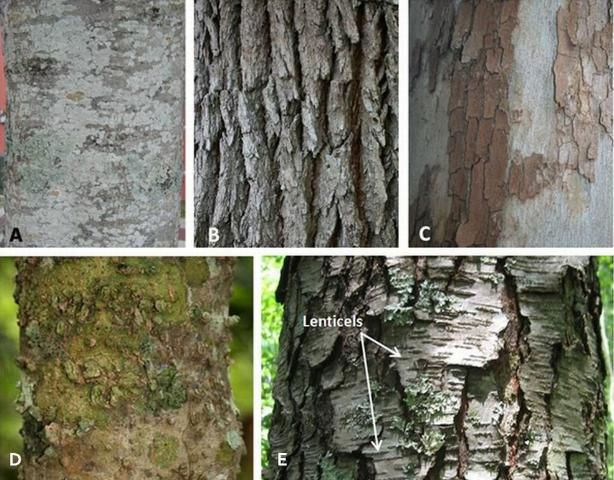
Credit: A, B, D, and E: Michael G. Andreu, C: Erin M. Givens
It is important to remember that the bark of a tree can change in color and texture with age. For example, the lenticels of a black cherry tree (Prunus serotina) look like dots covering the surface of brown bark and twigs when the tree is young (Figure 3A). As this tree matures the lenticels elongate and become horizontal striations (or parallel lines) on the bark's exterior (Figure 3B).
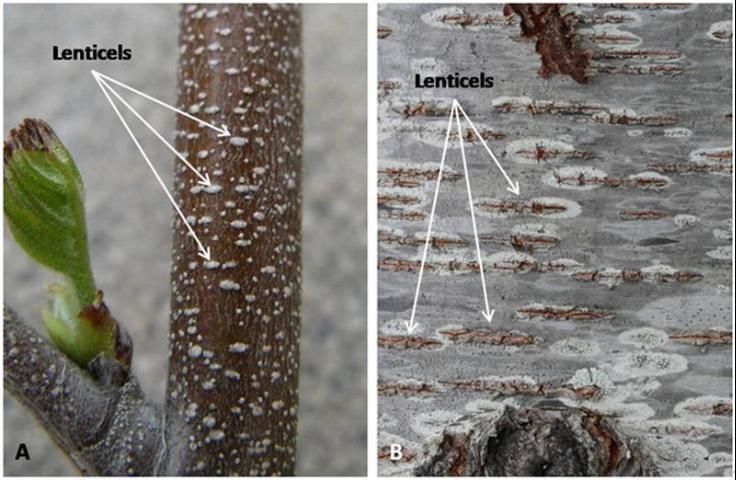
Credit: Walter Givens
Leaves
Leaves can be a determining factor when trying to identify a tree. In fact, there are many trees that can be identified by the leaf alone. Leaves are highly variable ranging from the needlelike leaves you see on pine trees (Pinus spp.) (Figure 4A) to the broad leaves of sycamore trees (Figure 4B). Leaf characteristics such as their persistence, structure, complexity, shape, venation, surface, smell, taste, and arrangement on the branch, all help to determine what species a tree is. Take your time when reviewing the diagrams and pictures below, as they will help you learn how to recognize some of these leaf characteristics.
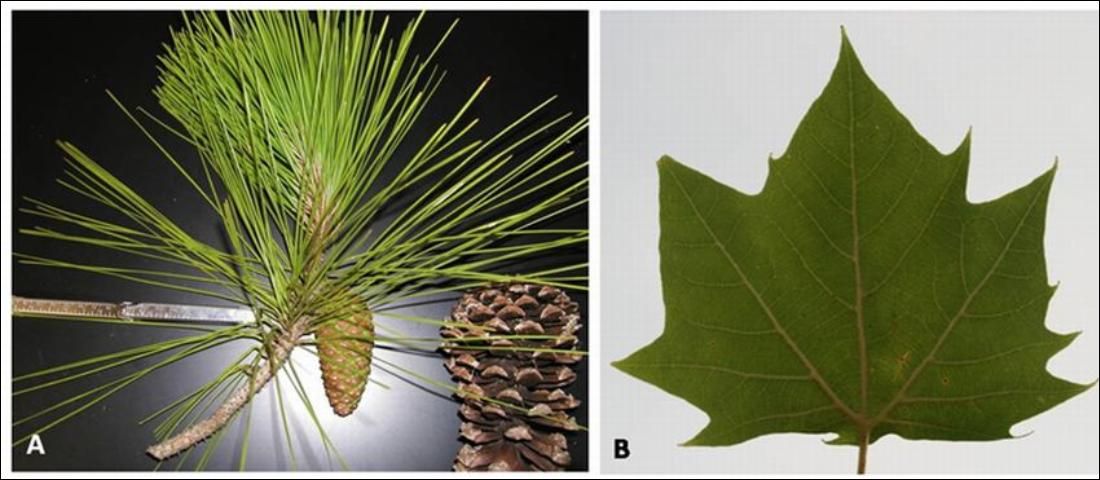
Credit: A: Michael G. Andreu, B: Erin M. Givens
Leaf Persistence
Leaf persistence refers to trees that are evergreen and maintain their leaves year-round or deciduous and shed their leaves during cold and/or excessively dry times of the year. While it may be challenging to know whether a tree is evergreen or deciduous during the warmer months of the year, leaf persistence is a useful filter when you're trying to identify a tree. For example, laurel cherry (Prunus caroliniana) and black cherry may appear similar, but you can distinguish between the two during the colder months of the year if you know that laurel cherry is evergreen and black cherry is deciduous.
One way to determine leaf persistence is to look at older twig growth (previous seasons) vs. new twig growth (current season). On many plants, you can identify where new growth began by locating the terminal bud scar nearest the end of the twig (Figure 5). All growth between the end of the twig and its nearest terminal bud scar is new growth. If you only see leaves on this portion of the twig, you are probably looking at a deciduous species. This is because deciduous plants shed these leaves after the season is over. When the next season comes around, the plant puts out leaves on new twig growth. However, if you see leaves present (i.e. "persisting") on an older portion of the twig, that plant is an evergreen species.
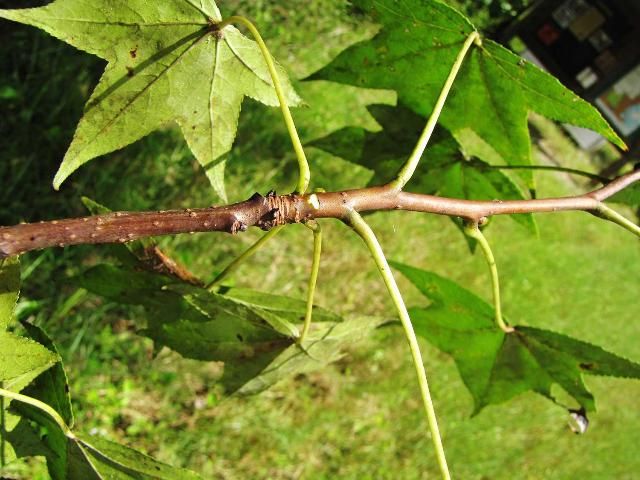
Credit: Lynn Proenza
While you can be fairly certain that species with leaves on older sections of a twig are evergreen, more care must be taken to declare a tree deciduous. This is because the absence of leaves on old growth twigs can also be due to leaves dying or falling off for a variety of reasons other than seasonal shedding. Therefore, it is always a good idea to look at multiple twigs, and multiple specimens, when trying to determine leaf persistence.
Leaf Structure
Leaf structure refers to the parts that make up a leaf. Generally, a leaf has a blade, a petiole, and sometimes stipules (Figure 6). The leaf blade is the expanded portion of the leaf, the petiole is the supporting stalk that connects the leaf blade to the branch, and stipules are small vegetative structures that form at the base of the petiole or on the twig.

Credit: Michael G. Andreu
Some trees have stipules that are persistent and others have stipules that drop off shortly after leaves emerge. In some cases the scar left by the stipule is distinctive and can help identify the tree. For example, tree species in the Magnolia family (Magnoliaceae) have a stipule scar completely surrounding the twig (Figure 7). Knowing this can help to distinguish between a sweetbay magnolia (Magnolia virginiana) and a swamp bay (Persea palustris), both of which can look similar and grow on similar sites. Learning which trees do and do not have these leaf parts can be helpful for identifying trees.
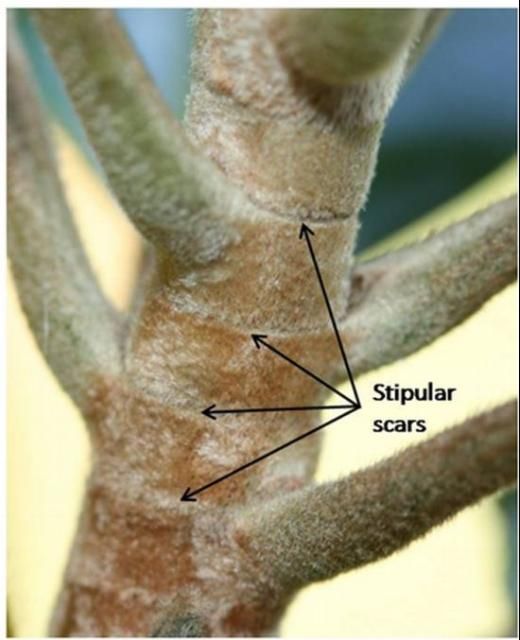
Credit: Walter Givens
Leaf Complexity
Leaf complexity refers to whether the leaf is simple or compound. If a leaf has a single blade, it is simple (Figure 6); usually you can see a bud where the leaf meets the stem or branch. If the leaf has multiple blades attached to a common stalk or petiole, then it is compound and the individual blades are called leaflets. Compound leaves can be pinnately, bi-pinnately, trifoliolately, or palmately compound (Figure 8). You can determine if a leaf is simple or compound by looking for a bud at the base of the leaf. If you cannot find a bud below a leaf, you may be looking at a leaflet which is part of a compound leaf. Leaf complexity is a great filter because most tree species have simple leaves. If your tree has compound leaves, then you can eliminate a large number of tree species that have simple leaves and consequently get closer to determining which species you're observing.
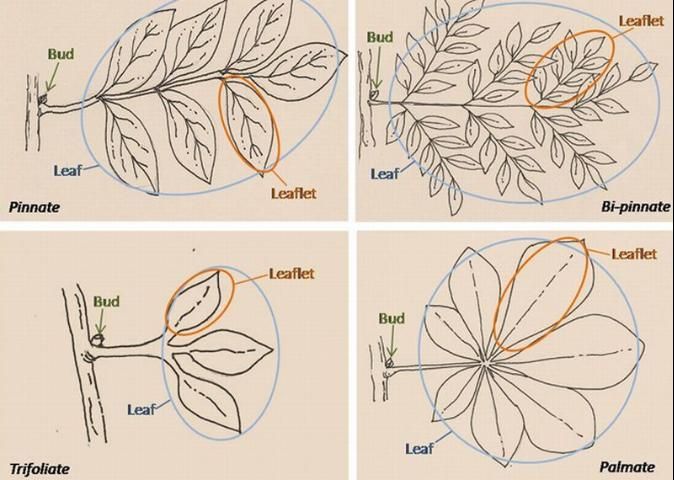
Credit: Line drawings by Becky Brown
Leaf Arrangement
Leaves can be arranged along a twig in one of three ways: alternate, opposite, or whorled. Alternate arrangement is when one leaf is attached at each node and the leaves emerge in an alternating pattern on the twig (Figure 9A). Opposite arrangement is when leaves emerge paired on each side of the twig (Figure 9B). Whorled arrangement is when more than two leaves are found at the same node (Figure 9C). Leaf arrangement is another great filter because while many trees species have an alternate leaf arrangement, fewer species exhibit opposite or whorled leaf arrangement. Therefore, you can narrow your list of potential trees when you see a particular type of leaf arrangement. Examples of trees with opposite leaf arrangements include the various species of maple (Acer spp.) and ash (Fraxinus spp.).
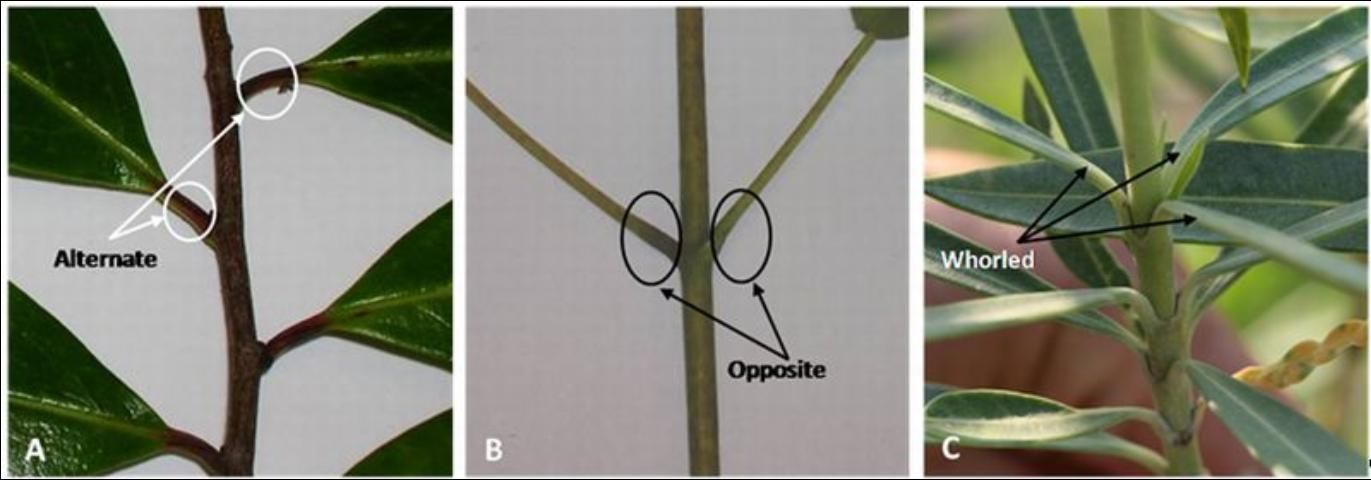
Credit: A and B: Mary E. Thornhill, C: Walter Givens
Leaf Shape
The overall shape of the leaf or leaflet blade can often help you to identify the tree. Botanists have developed names and descriptions for all of the leaf shapes in nature. For example, a long, slender pine needle is described as acicular (Figure 4A and Figure 10). Additional common leaf shapes are: deltate, elliptical, lanceolate, linear, obovate, and reniform (Figure 10).
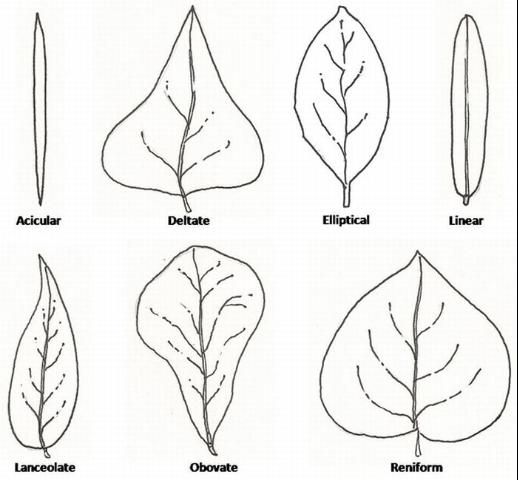
Credit: Line drawings by Becky Brown
Leaf size and shape may vary due to environmental conditions or due to a tree's physical growth habits. For example, if a tree is shaded by other trees growing near it, the leaves found near the top of the shaded tree may be very different from those found near the base of the same tree. In the shaded areas, larger leaves maximize the amount of surface area exposed to sunlight. Leaves that are exposed to full sunlight and wind (usually near the top of the tree) are usually smaller. One might think that the shapes of leaves for a given tree species would be constant but in fact the leaves of some tree species can vary considerably (Figure 11). This natural variation can be confusing and frustrating for beginners, but it is also fascinating when you begin to speculate why the variation occurred. The key is to use all of the tree's characteristics rather than focusing on one particular trait to determine what kind of tree it is.

Credit: Michael G. Andreu
In addition to naming and describing leaf shapes, botanists have also classified the many different types of leaf margins (Figure 12A), leaf tips or apices (Figure 12B), and leaf bases (Figure 12C). Figure 12 illustrates these three characteristics on an eastern redbud (Cercis canadensis) leaf. The leaf margin or edge of this redbud leaf is smooth (with no serrations or dentations) and is called entire. This leaf also has a short-acuminate apex and its base is cordate or heart shaped.

Credit: Walter Givens
Leaf Venation
Leaf venation refers to the branching pattern of the leaf's veins. Two common types of leaf venation are pinnate (having veins emerging on either side of the mid-vein) and palmate (primary veins emerging from a single point like fingers from the palm of a hand) (Figure 13). While venation may seem like a subtle characteristic to observe for identification purposes, it can be a very distinct characteristic for some tree species and is therefore useful in the tree identification process.
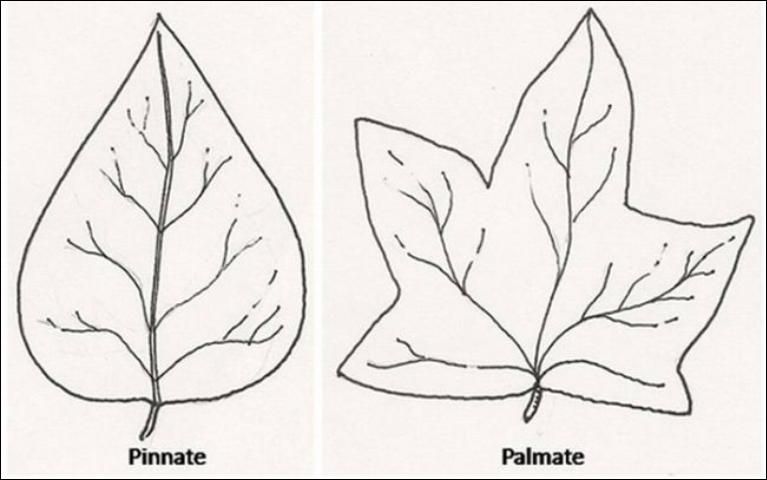
Credit: Line drawings by Becky Brown
Leaf Surface
The leaf surface can be characterized by its texture, thickness, and color, and by the presence or absence of hairs (pubescence). Leaves with hairs are called "pubescent," and those without are called "glabrous." Many leaf surface characteristics can be determined by looking at or feeling the leaf, but some may require a hand lens or some kind of magnification to view, such as the presence of very small hairs or small glands. Be sure to look at the top and bottom surfaces of the leaf to evaluate all of its characteristics.
Trees have various leaf textures; some leaves are smooth to the touch while others are rough. Leaf texture can be a useful characteristic to distinguish two species that are similar in appearance, for instance, American elm (Ulmus americana) and slippery elm (Ulmus rubra). American elm has a smooth upper leaf surface while slippery elm has a rough upper leaf surface. In some cases leaves have glands on their surfaces, which causes the leaf to feel slightly bumpy or to appear to glisten while other leaves feel or look waxy. Leaf thickness also varies; some leaves are thick and leathery and some are thin and light. In Florida, some find it difficult to distinguish a live oak leaf from a laurel oak (Quercus laurifolia) leaf. However, the live oak leaf is typically thicker than a laurel oak leaf, and knowing this can help to distinguish these two species from one another. The presence or absence of hairs on the leaf surface will also help distinguish the many different tree species you observe. Finally, it is important to observe the colors of the upper and lower surfaces of a leaf. Leaves can be dark green, light green, bluish-green, or rust colored. This may also help distinguish between live oak, which is lighter green on the underside of the leaf than on the top, while laurel oak is the same green color on both surfaces. Another example is southern magnolia (Magnolia grandiflora), which has a rusty-orange pubescent underside (Figure 14B). This characteristic in combination with its thick leathery leaves and smooth bark makes this species very easy to identify.

Credit: Melissa H. Friedman
Leaf Smell or Taste
When examining the tree, you should use all of your senses. What does the leaf smell like when crushed in your hand? Is the odor strong or barely noticeable? Distinguishing sweetgum (Liquidambar styraciflua) from red maple is not always easy (Figure 15), but if you crush a leaf of both species you will be able to smell the difference. Sweetgum has a very distinct (not unpleasant) aroma while red maple does not smell at all. You can also taste leaves, but use caution, because some tree leaves are toxic! For those non-toxic species, you can taste whether they are bitter or sweet. For example, if you taste the black cherry tree leaves, you will find they taste bitter, and sourwoods (Oxydendrum arboreum) are named for their sour-tasting leaves.
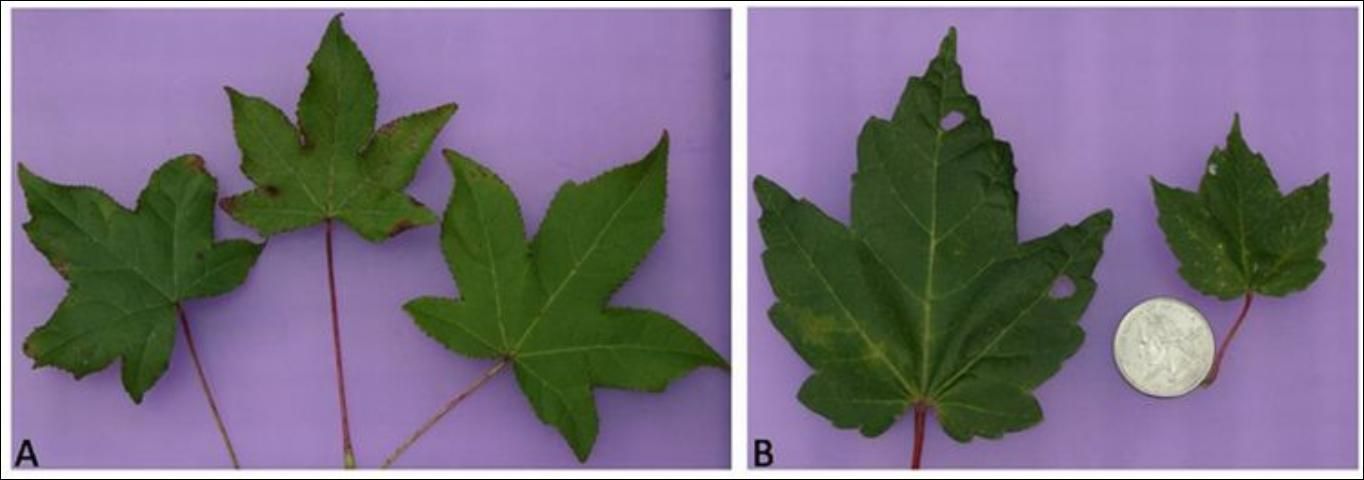
Credit: Michael G. Andreu
Twigs
The next tree characteristic that will help you identify what species you have is the twig. It is best to focus on the most recent twig growth because the older branches lose some of their key features. Usually the new growth of a twig is green, but in some cases it may be brown (Figure 16). The most important features of the twig are its buds, scars, lenticels, pith, and thorns, all of which are discussed further in the following sections.
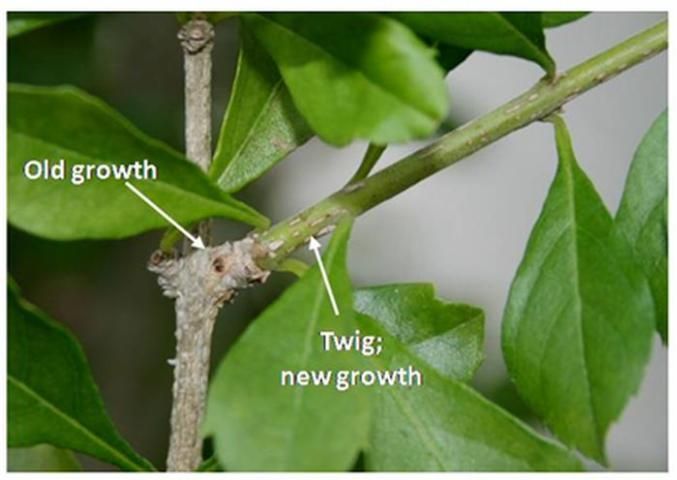
Credit: Walter Givens
Buds
Buds are growth or potential growth points on a twig. There are two types of buds: axillary and terminal buds (Figure 17). Axillary buds are the buds located at the point where the leaf meets with the twig. The terminal buds are located at the tip or apex of the twig; they are usually larger than the axillary buds.
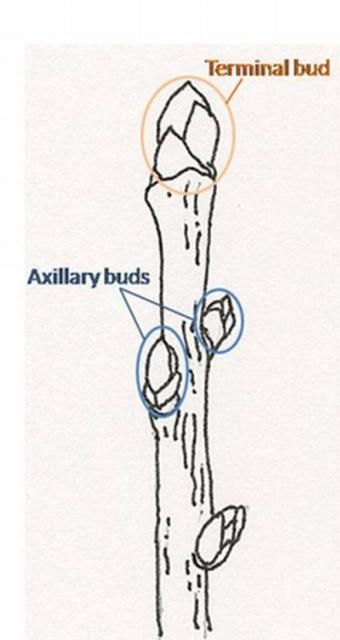
Credit: Line drawing by Becky Brown
Buds are either scaly or naked (Figure 18A and B). Bud scales are modified leaves or stipules that protect the growing portion of the twig. Naked buds lack scales and are common in trees that originate in tropical climates.

Credit: Michael G. Andreu
Scars
A leaf scar is found on the branch or twig at the point where a leaf was once attached. The shape and size of leaf scars can be distinguishing features that will help you identify a tree species. If you look closely at the leaf scar (you may need a hand lens), you may see one or more dots known as vascular bundle scars. This is where the strands of the plant's vascular tissue (equivalent to veins and arteries) pass from the twig to the leaf. The leaf scar's size and shape and the number of vascular bundles are unique features that are very useful for tree identification, especially in the winter when there are no leaves to observe. For example, Figure 19 illustrates a leaf scar on a sweetgum tree that has three vascular bundles.

Credit: Walter Givens
Another type of scar that may be present on the twig is the stipular scar. Remember, stipules are the small, leaf-like structures that form at the petiole base or on the twig (see Figure 6). When the stipules fall off they leave stipular scars. Generally, if the tree has stipules they occur in pairs. The stipular scars for each stipule would occur on the top of the leaf scar. In a few species, the stipular scars are fused together and encircle the twig. For example, magnolias have stipular scars that encircle the twig (Figure 7). If you see this, there is a good chance that the tree you're examining is a type of magnolia or tulip poplar (family Magnoliaceae) or sycamore (family Platanaceae).
Lenticels
As stated earlier in the "bark" section, lenticels are raised, cork-like areas on tree bark that expose the underlying tissue to air. Lenticels vary in shape and size from species to species, and on the same tree. The shape and size of the lenticels may also change as the tree ages. Lenticels can be horizontal (Figure 3B) or vertical striations, or dots (Figure 3A).
Pith
The center portion of the twig is called the pith. The pith usually has a different color and texture than the wood around it. If you take a cross-section of the twig (cut the twig in half longitudinally) (Figure 20), you will be able to observe the pattern of the pith.
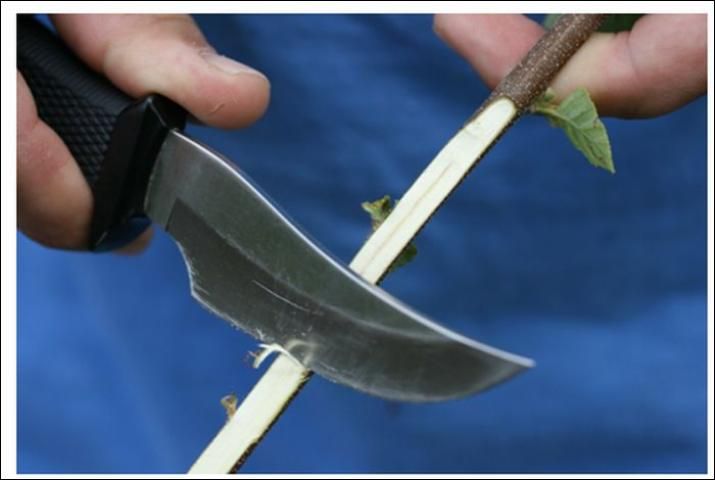
Credit: Erin M. Givens
The pith can be diaphragmed; partitions or bars exist across the pith (Figure 21A), chambered; divided into empty chambers (Figure 21B), or continuous with no partitions (Figure 21C).
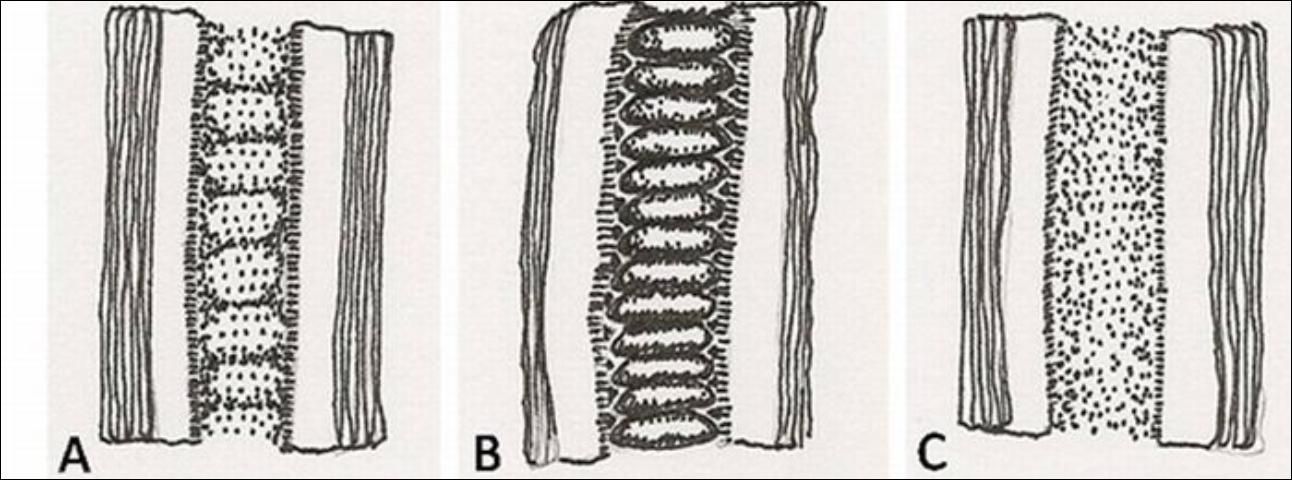
Credit: Line drawings by Becky Brown
Thorns
Pointed structures known as thorns, spines, and prickles are important characteristics for identifying some species because most tree species do not have them. Thorns can be located along the branches and twigs of a tree or they can be found along the main trunk (e.g. honey locust, Gleditsia triacanthos). Thorns are modified stems, spines are modified leaves, and prickles can occur anywhere on the twig or leaf (Figure 22).

Credit: Walter Givens
Flowers
Reproductive features, such as the flower, can sometimes be very distinctive for tree identification. While some flowers of trees are showy (flowering dogwood, Cornus florida) other tree flowers are inconspicuous and small (oaks). Therefore, the flowers (if visible) must often be used in conjunction with other characteristics for identification.
Trees that have flowers are called angiosperms. Flowers generally have four parts: sepals, petals, stamens, and pistils (Figure 23). If a flower has all of these parts it is called complete. If it is missing any of these parts it is called incomplete. When a tree is flowering, it has reached the point when the flower is mature and pollination is possible.
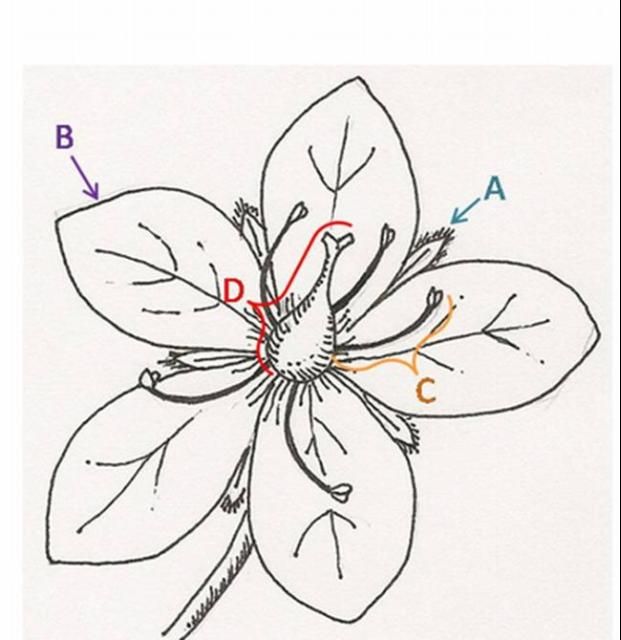
Credit: Line drawing by Becky Brown
Flowers may be single or in clusters. The arrangement of several flowers on a branch system is called inflorescence. Some of the more common inflorescence types are spike, catkin, raceme, panicle, cyme, umbel, and head (Figure 24).
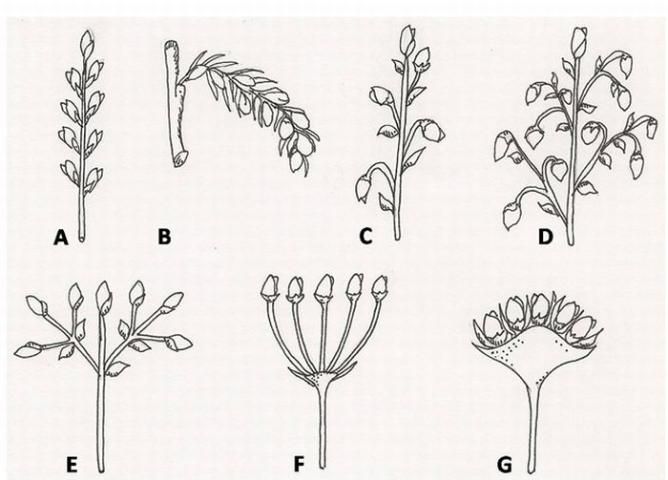
Credit: Line drawing by Becky Brown
It is important to remember that some trees lack "flowers" and instead bear their seeds in cones (Figure 25A) or berry-like structures (Figure 25B). These types of trees are called gymnosperms. Examples of gymnosperms commonly found in Florida are pines (Pinus spp.), eastern redcedar (Juniperus virginiana), and cypress (Taxodium spp.). Florida is also home to two other gymnosperm tree species that are considered uncommon or rare, the Florida yew (Taxus floridana) and the Florida Torreya tree (Torreya taxifolia).
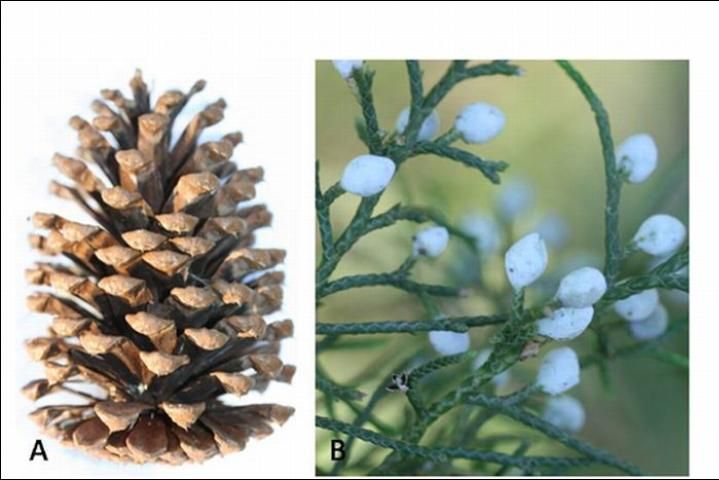
Credit: Walter Givens
Fruits and Seeds
Fruit structure is often very unique and can be a great way to identify the tree. You often find the fruit of a tree lying on the ground below it, which is ideal because it allows you to examine it closely; just make sure the fruit comes from the tree you are trying to identify. Binoculars can be very helpful for examining tree leaves and fruits that are out of reach.
When the ovary inside of the flower is pollinated, a "ripened" ovary or fruit is produced. An apple (Figure 26) is a delicious example of the fruit produced after the ovary of the flower has been pollinated.
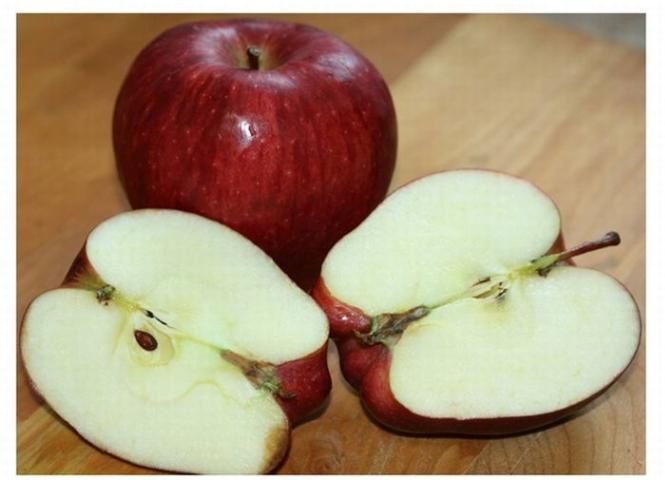
Credit: Walter Givens
The fruit or ovary houses the seed(s) and the ripened seed(s) house an embryo inside. As a seedling begins to develop, the fruit provides nourishment for it. Figure 27 shows examples of various tree fruit types.
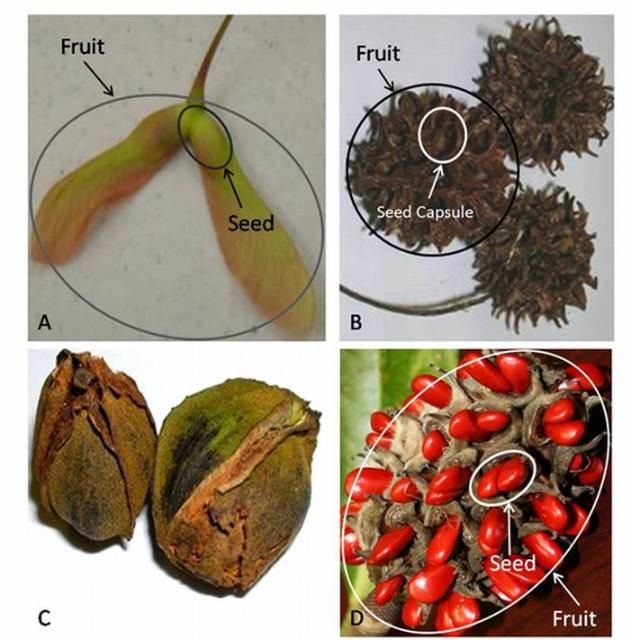
Credit: A–C: Mary E. Thornhill, D: Michael G. Andreu
Conclusion
Learning how to identify a tree is not easy, especially in the beginning! It requires patience and perseverance. Take notes on any and all of the characteristics you can observe that have been discussed in this publication. The Tree Identification Sheet provided in Appendix A at the end of this publication will remind you of those characteristics that will help you identify a tree. If you cannot observe a certain characteristic listed on the sheet, leave it blank. Then use your field guides and try to determine what tree species you have based on your field observations. After you have identified the tree, it's good practice to use your reference material to fill in the characteristics you were not able to observe. This "filling in what you missed" will help you learn more about the tree and become more familiar with the characteristics that can be used to identify this tree. It will be a great resource, too, if you should choose to build your own database. Most importantly, highlight the characteristics that you found easy to observe and unique to the tree. These key characteristics will help you identify the tree in the future. Remember, sometimes there are variations in a tree's characteristics (e.g., leaf characteristics). Expect to encounter these variations, which show trees adjusting to changes in their environments. Variation can be a challenge, but it also keeps tree identification fun and exciting!
Acknowledgements
The authors would like to acknowledge Becky Brown for her contribution of line drawings along with Walter Givens and Mary E. Thornhill for their photo contributions. Labeling and graphical illustrations on photos and line drawings were created by Melissa H. Friedman. Additional gratitude is extended to Lynn Proenza and Luisa Falck for their input and ideas, Alan Long for his reviews and comments, and Susan Gildersleeve for her assistance with editing.
Reference List
Legend: Range: §, Habitat: #, Bark: †, Leaf Shape: ×, Flowering Trees: +, Seed Structure: *
Beentje, H. 2010. The Kew Plant Glossary: An illustrated dictionary of plant terms. Kew Publishing. (×)
Brown, Claud L. and L. Katherine Kirkman. 1990. Trees of Georgia and Adjacent States. Timber Press. (†)
Duncan, Wilbur H. and Marion B. Duncan. 1988. Trees of the Southeastern United States. The University of Georgia Press. (×)
Florida Natural Areas Training (NFAI): http://www.fnai.org/ (#)
Floridata: http://www.floridata.com/ (+)
Godfrey, Robert K. 1988. Trees, Shrubs, and Woody Vines of Northern Florida and Adjacent Georgia and Alabama. University of Georgia Press.(+,*)
Hardin, James W., Donald Joseph Leopold, and Fred M. White. 2001. Harlow & Harrar's Textbook of Dendrology, ninth edition. McGraw-Hill. (×)
Kirkman, L. Katherine, Claud Brown, and Donald J. Leopold. 2007. Native Trees of the Southeast. Timber Press, Inc. (×)
Kurz, Herman and Robert K. Godfrey. 1993. Trees of Northern Florida. University of Florida Press. (×)
Meyers, Ronald L and John J. Ewel, editors. 1990. Ecosystems of Florida. University Presses of Florida. (#)
National Audubon Society Field Guide to North American Trees – Eastern Region. 1980. Knopf Doubleday Publishing Group. (§,†,+,*)
Nelson, Gil. 1994. Trees of Florida: A reference and field guide. Pineapple Press. (×)
Stebbins, Mark. 1999. Flowering Trees of Florida. Pineapple Press. (+)
Stein, John, Denise Binion, and Robert Acciavatti. 2003. Field Guide to Native Oak Species of Eastern North America. USDA Forest Service. *
USDA Forest Service website for Silvics in North America: http://www.na.fs.fed.us/spfo/pubs/silvics_manual/table_of_contents.htm (§)
USDA Natural Resource Conservation Service Plants Database: http://plants.usda.gov/ (§)
Whitney, Ellie, D. Bruce Means, and Anne Rudloe. 2004. Priceless Florida: Natural Ecosystems and Native Species. Pineapple Press. (#)